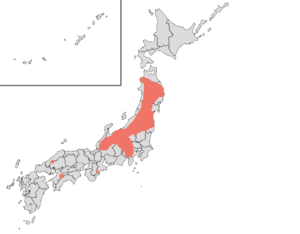Endo's pipistrelle facts for kids
Quick facts for kids Endo's pipistrelle |
|
|---|---|
| Conservation status | |
| Scientific classification | |
| Genus: |
Pipistrellus
|
| Species: |
endoi
|
 |
|
| Distribution of Endo's pipistrelle | |
The Endo's pipistrelle (Pipistrellus endoi) is a small bat that lives only in Japan. It's a type of vesper bat, which means it's active at night. You can usually find these bats living in cool, temperate forests.
Contents
How it Got its Name
This bat was first described in 1959 by a Japanese scientist named Yoshinori Imaizumi. He named it endoi to honor Kimio Endo. Kimio Endo had found some very important bat samples in Iwate Prefecture, Japan. One of these samples was the first known example of this new bat species.
What it Looks Like
The Endo's pipistrelle looks a lot like the Japanese house bat. However, there are some small differences in their bones. This bat is quite small. It weighs about 5.6 to 8.7 grams, which is less than a quarter of an ounce. Its forearms are about 30.8 to 34.2 millimeters long. That's roughly 1.2 to 1.3 inches.
Life Cycle and Habits
Endo's pipistrelles mate in the autumn. Female bats give birth to their young during the summer months. We don't know the average number of babies they have at once. However, scientists have seen mothers with two babies (twins).
These bats hibernate during the colder months. They have been found sleeping from November through March. They often choose cracks in rocks as safe places to hibernate.
Where it Lives
Most Endo's pipistrelles have been found living in forests. This suggests they really need forests to survive. But in 2006, one bat was found in a forest near the city of Tokyo. This shows they might sometimes live closer to people. These bats have been found at different heights, from about 100 meters (328 feet) to 1,500 meters (4,921 feet) above sea level.
Protecting the Species
The IUCN lists the Endo's pipistrelle as "near-threatened." This means it could become endangered in the future. There are a few reasons for this concern. The places where these bats live are shrinking and becoming less healthy. Also, the bat population is expected to drop by 20-30% between 2019 and 2034. This bat is also naturally uncommon, which makes it more vulnerable.


